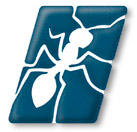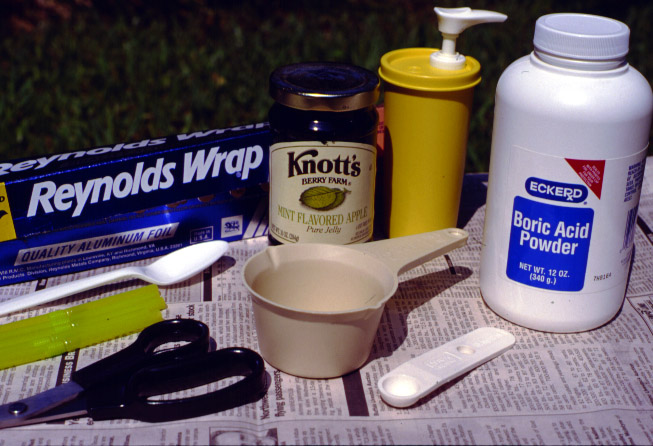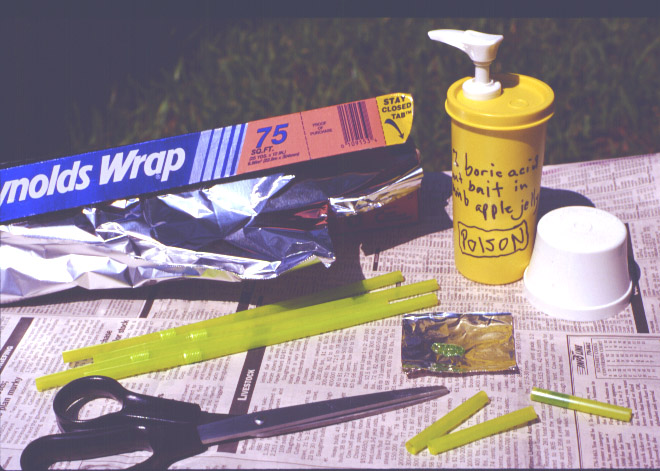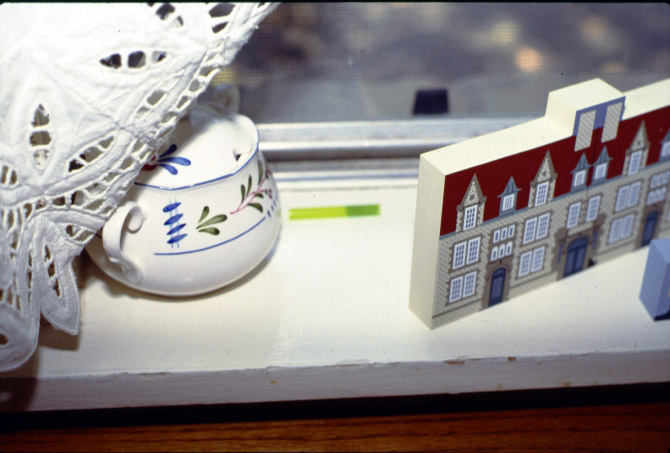 Home-Made Boric Acid Mint-Apple Jelly
Bait for Indoor Ant Control
Home-Made Boric Acid Mint-Apple Jelly
Bait for Indoor Ant Control Home-Made Boric Acid Mint-Apple Jelly
Bait for Indoor Ant Control
Home-Made Boric Acid Mint-Apple Jelly
Bait for Indoor Ant Control
Nuisance ant species in the home, such as the Pharaoh ant, Monomorium pharaonis, can be controlled using a variety of different methods (see publication L-2061 House-Infesting Ants and Their Management). One of the methods discussed is the use of boric acid bait stations. Pharaoh ants are omnivorous, feeding on sweets (jelly, particularly mint-apple jelly, sugar, honey, etc.), cakes and breads, and greasy or fatty foods (pies, butter, liver and bacon). Nests are rarely found outdoors and almost anywhere indoors (light sockets, potted plants, wall voids, attics, in any cracks and crevices) particularly close to sources of warmth and water. Nuisance ants are often found in window sills where they feed on dead insects.
Proper identification of the nuisance ant species is an important first step to controlling them effectively. If red imported fire ants are found indoors, consider treating colonies outside the structure as described in Extension publication, B-6043, Managing Red Imported Fire Ants in Urban Areas, also found on the web site, http://FireAnt.TAMU.edu/ . Also, try following ant trails to find where their nest is located or if they are coming indoors from outside nesting sites.
Boric acid is a slow-acting stomach poison. It is commonly formulated as a dust or liquid bait for indoor control of ants. Boric acid powder can be purchased at any pharmacy.
Choose the most attractive food material for the ant species present, e.g., peanut butter, mint apply jelly, corn syrup, etc.
Mix 1 part boric acid powder per 100 (or 50) parts bait material, e.g., 1 teaspoon per 2 (or 1) cups food material to make a 1% (or 2%) bait.
Do not make the bait concentration of boric acid too strong as this reduces its acceptance. The one percent bait is better than higher concentrations since it is less repellent to the ants and kills ants as efficiently. Keep the bait fresh and moist. Small quantities of bait can be placed in bottle caps or on pieces of tin foil, or injected into short (2 inch long) sections of soda straws using a squeeze bottle. Place 20 to 30 small bait stations where ants have been seen or where attracted to baits as described in the previous section. Do not place stations in areas accessible to small children or pets. If the proper food is used and the bait is kept fresh, control should be achieved after 3 to 4 weeks for a careful, thorough baiting program.
For outdoor use, a boric acid solution can be made by mixing 1 tsp. boric acid, 3 Tbsp. sugar in 2 cups water, placing it in a container plugged with a cotton ball, and laying it on its side near an ant hill (from a quote from David Williams, USDA, Organic Gardening Magazine, March 1997). However, organic gardeners feel that boric acid should not be used outdoors since it can be toxic to plants.
Effective bait formulations contain slow-acting pesticides that are collected by foraging worker ants and brought back to the colony where the pesticide is fed to the other ants, queen(s) and brood. Tips for success when using baits to control house-infesting ants include:
Use enough stations or material to treat the infestation.
Enhance bait effectiveness by removing or covering other food sources which compete with the attractiveness of the bait.
Avoid the use of any surface applications of long-acting contact insecticides (often applied to control cockroaches or to ant trails) that would prevent foraging worker ants from being capable of reaching the bait station before and during baiting efforts.
Be patient for the baits to work. Three to four weeks or more may be required to eliminate some colonies.
| Example for making a 1:100 Mint-Apple Jelly Bait Station: | |||||||||||
|---|---|---|---|---|---|---|---|---|---|---|---|

| Step 1: Assemble supplies:

Step 2:
Add ¼ tsp boric acid powder
to ½ cup mint-apple jelly
or other attractive material
(Note: adding peanut butter may make the bait more attractive
to oil and grease feeding ant species).
Stir well. Wash or discard all utensils after use.
Do not use them for any other purpose.
| | 
Step 3:
Squeeze mixture into soda straws cut into 2 inch lengths.
Alternatively, cut foil paper into 2 inch squares on which
to squeeze bait. Mark squeeze bottle "poison" with a
description of contents. Do not use for any other
purpose and keep out of reach of children.
| 
Step 4:
Place soda straws containing ant bait or foil paper
squares in areas where ant activity has been observed.
The more stations the better.
Do not place stations where they
may be consumed by small children.
Remove other sources of food which may be attractive to the
ants and detract from the bait station.
Monitor stations and re-fill as needed.
Be patient for ant activity to cease.
Note: This bait is attractive to Pharaoh ants,
but may not be attractive to other ant species.
| Acknowledgments:
| The author is grateful for the constructive comments and reviews from Dr. David Oi of the USDA Agric. Research Service; Dr. Paul Nester, Extension Agent IPM (Fire Ant Project); and Grady Glenn of the Center for Urban and Structural Entomology at Texas A&M University. The information given herein is for educational purposes only. Reference to commercial products or trade names is made with the understanding that no discrimination is intended and no endorsement by the Texas Agricultural Extension Service or the Texas Agricultural Experiment Station is implied. Educational programs conducted by the Texas Agricultural Extension Service serve people of all ages regardless of socioeconomic level, race, color, sex, religion, disability or national origin. FireAnt.TAMU.edu FactSheets | |||||